The Conversation: Gene Hackman’s Raincoat | Clothes on Film
© 2012, Clothes on Film 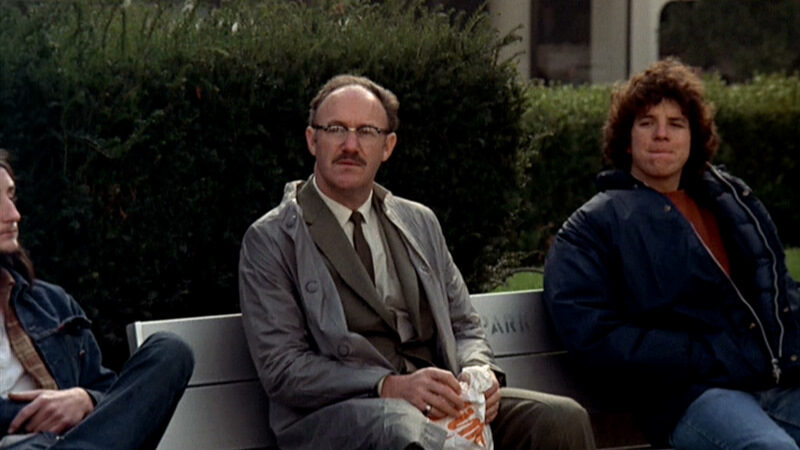
13 Mar ’12 Filed under Clothes from 1970s, Girls in Films, Guys in Films, Interviews. Tagged 1960s, Aggie Guerard Rodgers, Beetle Juice, Clothes from 1970s, cocktail dress, colour palette, Francis Ford Coppola, Gene Hackman, Halston, Harrison Ford, Harry Caul, identity, interview, One Flew Over the Cuckoos Next, plastic raincoat, raincoat, Return of the Jedi, shirt, Star Wars, suit, tailor, Terri Garr, The Color Purple, The Conversation, tweed. Bookmark the permalink. Post a comment. Leave a Trackback (URL).
The life of surveillance expert, Harry Caul (Gene Hackman) in The Conversation (1974, directed by Francis Ford Coppola) is one of ritual, fear and obsession. This man of many facets is identifiable by the clothes he wears, specifically because of their bland anonymity and repetition. His plastic raincoat in particular, a rudimentary raglan slip-on, provides recognisable iconography for the character. With exclusive insight from The Conversation costume designer, Aggie Guerard Rodgers, we analyse just why this coat is so important to Harry’s journey.
Stumbling on a murder plot during a routine, if technically accomplished clandestine recording, Harry becomes obsessed with subduing his Catholic guilt over past deeds. Harry lives alone with little furniture and barely any personal possessions, his saxophone and a small statue of the Virgin Mary being two notable exceptions. If he is a hero he is unlike any we have met before. Reluctant, proud and flawed from a young age, now Harry attempts to save the life of a young philandering couple, Ann (Cindy Williams) and Mark (Frederic Forrest), whose lives he believes are in danger. Partly to save his soul, partly just to prove he is right.
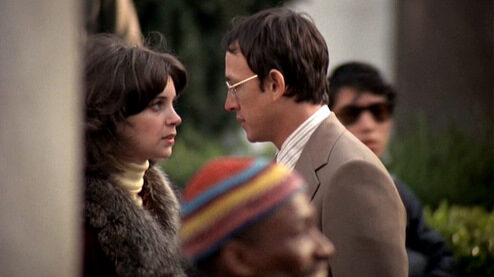
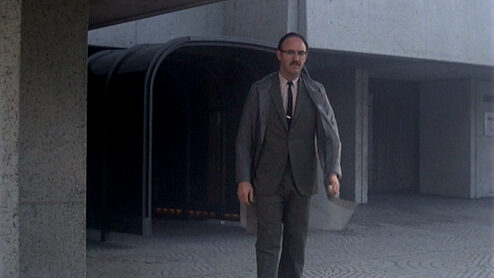
Harry is a complicated man, quite unlike his wardrobe, comprising a drab collection of green-tweed, grey suits and one more slightly luxurious silk mix for attending a security convention. All are two-button single breasted and somewhat ill-fitting as they are likely at least a decade old. Aggie Guerard Rodgers was given specific instructions by Francis Ford Coppola to costume Gene Hackman in this way. She recalls her time on the film:
“I had met Mr. Coppola on American Graffiti as he was a producer on that job. I had grown up in a town near Mr. Lucas and dragged the main street with my sister, which is really how I got that job. But as far as doing movies that did not include saddle shoes and petticoats, that was a stretch. I did not even know how to break down a script – the script woman had to teach me! Not many of us were really qualified to do this film, but we were local and that’s what was happening then as it is now. On we went.”
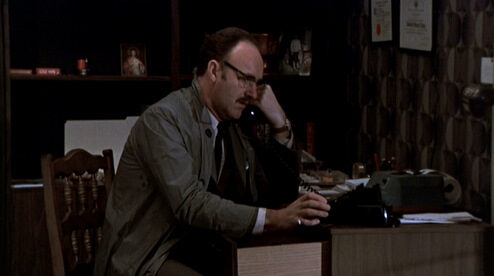
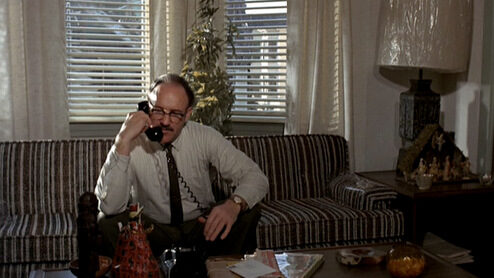
Inexperienced in the business, Guerard Rodgers freely admits that she found her way through the shoot and is full of admiration for her director and star. Yet, this was the nature of filmmaking in the 1970s, so fresh and unrestrained that a template had not even been established.
“When we started on the film the local I.A (import administration) was causing a bit of a stir so we stopped prepping a week before shooting. Being a beginner I stopped too until I heard from one of the producers that we need to keep shopping! He then took Cindy Williams out shopping and I went shopping with the production designer, Dean Tavolaris, Harrison Ford and Robert Duvall (‘The Director’) at a shop in San Francisco called Wilkes Bashford. It is still there but in a different location. It was fast and furious, but so much fun. How did I know we were on such an amazing film?”


The Conversation is often referred to as a character study, although really this term is redundant. Story is powered by the decisions of characters; they are the narrative. What however The Conversation achieves superbly is to place character at the centre of story. Remove Harry from the narrative and the film becomes a murder with no mystery. Harry’s presence is essential because he powers every turning point.
Harry’s costume throughout is so indicative of his actions that he hardly need speak at all. We can read his intentions, such as the simple act of donning his raincoat to initiate work – which in the context of the story amounts to anything relating to the murder plot (note that he removes it immediately after completing the live recording of Ann and Mark). He even wears the coat while dreaming. His reasons for wearing this raincoat are left ambivalent, like much of The Conversation, but further clues can be drawn as to the nature of his personality. It is translucent, implying his paranoia of being bugged, something that eventually happens when he is not wearing the coat. Also it harbours connotations of sleaziness and shame, both of which dog Harry on a daily basis. Guerard Rodgers clarifies where the idea for this unusual item came from:
“Mr. Coppola chose the kind of raincoat that Mr. Hackman wore. He told me exactly what he wanted. I went to an army surplus store there called Kaplan’s and bought two dozen raincoats in a little pouch. They rip easily so I got a lot! It was a play on Mr. Hackman’s character name – Harry Caul, so it was kind of creepy to me. We used the same kind of reference on the clothing that Frederic Forrest and Cindy Williams wore when they murdered Mr. Duvall’s character. They had on plastic rain suits so as to not get their clothing covered with blood. It could be seen in many ways – you pick what you think. I think it is a way to keep people out really. The characters were all people who were afraid of life; sad characters, unsettling really.”


Harry contrasts with other characters in the story. Police detective Paul (Michael Higgins), for example, whose grey pinstripe suit Harry admires, subtly suggesting his own dissatisfaction at being trapped by public anonymity. Also Martin Stett (Harrison Ford), meeting Harry for the first time in houndstooth tie, black suit and brown shoes; he could not be more visible. Even party girl Lurleen (Phoebe Alexander), who seduces Harry after the security convention. She is in place to make him appear less in touch with reality than the muddy uncertainty of his imagination:
“You know lots of the characters in the film wore green. It was where my head was then. The woman at the convention (Lurleen) who came back with the men to have a drink at Harry’s work space wore a green Halston two-piece cocktail dress. It being my second film I had to go the production designer to ask if I was spending too much money with an $800.00 dollar outfit! So, I started spending early in my career! My mind thinks that I felt all of them would start anew again; spring, renewal green. I had hope in these characters – sad but hopeful.”


Moreover, the convention caused more issues for Aggie Guerard Rodgers than just what certain characters should wear, by her own admission triggering a continuity issue on set that required a re-shoot:
“I did not have any one to help me on set so if I had to get more things I just told Mr. Hackman and Mr. Coppola I had to leave and off I went. It was wild! I did make a huge mismatch during filming with the convention tag as I had sent out his suit on a Saturday and did not notice that I had not put it back on until Wednesday! I was a mess! Mr. Hackman and I went to the script woman and the prop man and said yikes! So then we went to Mr. Butler, the director of photography, and told him… I was sure when it happened we went to Mr. Coppola and told him and then we shot a small scene that is still in the film of Mr. Hackman taking off his tag.
I was devastated with my lack of professionalism and was near collapse. Mr. Coppola called a break and sat down with me and calmed me down. I think we then had lunch and I had a big glass of red wine! This is how I really remember the workings of the film. It was wild for me. I was way, way over my head with all these very, very professional people.”

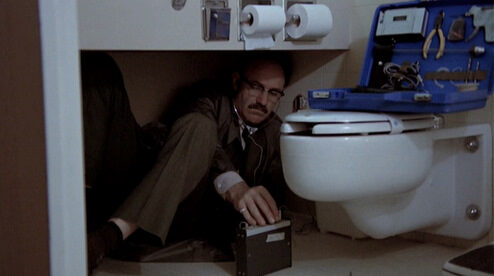
This split-second moment of Harry removing his convention name tag can be seen directly after guests leave his workspace and he is left alone with Lurleen. Very soon, Harry will have the tapes he is so desperately trying to protect lifted from right under his eyes. This marks the point in the story when he begins to get sloppy. During the post-convention party Harry let vanity powered by self doubt get the better of him and from now on he will inadvertently broadcast his every move.
Harry remains consistent in his clothes however. Still he dons the raincoat when bugging the hotel, where the shortness of his suit sleeves is clearly apparent. As with practically everything we see in costume, this was an intentional indicator of the person inside. Although the end result is probably subtextual to most, it serves character by designating our viewpoint. Whether we realise it or not, we are forming an opinion of Harry by what he wears. Guerard Rodgers expands this idea:
“I have spent lots of my time just trying to make people look like people and not in a costume. Harry’s clothes were not crisp or sophisticated, and they were a bit short in the sleeve, which I really liked. The suits were really from the 60′s, they were how people dressed in reality, just people, not actors. Just don’t over tailor anything if you want things to look real. Most people do not have a tailor in their lives; neither does everyone wear things that are totally in style with the fashion world. I find that really boring in the big films of today. You are trapped by a budget or stunts, or people with no imagination!”


We bid goodbye to Harry sitting in his ransacked apartment, contently playing saxophone due to the unburdening realisation that he has been beaten. His shirt deluged in sweat and slim-knotted tie still pinching his neck, he looks far from comfortable. And yet this is a man reborn. No longer trapped by painstaking methodology masquerading as talent, Harry is free to begin anew. The Conversation ends on a positive note, albeit ironically. Aggie Guerard Rodgers also found herself on the road to a rich and varied career, including such films as Beetle Juice (1988), Star Wars: Return of the Jedi (1983) and Oscar nominated for The Color Purple (1985):
“I tell you working on The Conversation changed my life. Because of it, I got to do One Flew Over the Cuckoos Nest, and then it went on and on. I am, as far as I am concerned, the luckiest woman in the world. Mr. Lucas, Mr. Coppola, Mr. Forman… What a life!”
With thanks to Aggie Guerard Rodgers.
You can watch Gene Hackman in The Conversation at LOVEFiLM.com.
© 2012, Chris Laverty.
Related Posts: